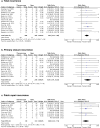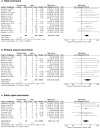Comprehensive meta-analysis of surgical procedure for congenital diaphragmatic hernia: thoracoscopic versus open repair
- PMID: 38980431
- PMCID: PMC11233350
- DOI: 10.1007/s00383-024-05760-7
Comprehensive meta-analysis of surgical procedure for congenital diaphragmatic hernia: thoracoscopic versus open repair
Erratum in
-
Correction to: Comprehensive meta‑analysis of surgical procedure for congenital diaphragmatic hernia: thoracoscopic versus open repair.Pediatr Surg Int. 2024 Aug 31;40(1):247. doi: 10.1007/s00383-024-05832-8. Pediatr Surg Int. 2024. PMID: 39215832 Free PMC article. No abstract available.
Abstract
Purpose: Previous studies have shown a higher recurrence rate and longer operative times for thoracoscopic repair (TR) of congenital diaphragmatic hernia (CDH) compared to open repair (OR). An updated meta-analysis was conducted to re-evaluate the surgical outcomes of TR.
Methods: A comprehensive literature search comparing TR and OR in neonates was performed in accordance with the PRISMA statement (PROSPERO: CRD42020166588).
Results: Fourteen studies were selected for quantitative analysis, including a total of 709 patients (TR: 308 cases, OR: 401 cases). The recurrence rate was higher [Odds ratio: 4.03, 95% CI (2.21, 7.36), p < 0.001] and operative times (minutes) were longer [Mean Difference (MD): 43.96, 95% CI (24.70, 63.22), p < 0.001] for TR compared to OR. A significant reduction in the occurrence of postoperative bowel obstruction was observed in TR (5.0%) compared to OR (14.8%) [Odds ratio: 0.42, 95% CI (0.20, 0.89), p = 0.02].
Conclusions: TR remains associated with higher recurrence rates and longer operative times. However, the reduced risk of postoperative bowel obstruction suggests potential long-term benefits. This study emphasizes the importance of meticulous patient selection for TR to mitigate detrimental effects on patients with severe disease.
Keywords: Bowel obstruction; Congenital diaphragmatic hernia; Meta-analysis; Minimally invasive surgery; Neonatal surgery; Thoracoscopy.
© 2024. The Author(s).
Conflict of interest statement
The authors declare no competing interests.
Figures





References
-
- Tennant PW, Pearce MS, Bythell M, Rankin J (2010) 20-year survival of children born with congenital anomalies: a population-based study. The Lancet 375:649–656. 10.1016/S0140-6736(09)61922-X - PubMed
-
- McGivern MR, Best KE, Rankin J et al (2015) Epidemiology of congenital diaphragmatic hernia in Europe: a register-based study. Arch Dis Child Fetal Neonatal Ed 100:F137–F144. 10.1136/archdischild-2014-306174 - PubMed
-
- Lund DP, Mitchell J, Kharasch V et al (1994) Congenital diaphragmatic hernia: the hidden morbidity. J Pediatr Surg 29:258–264. 10.1016/0022-3468(94)90329-8 - PubMed
-
- Jancelewicz T, Chiang M, Oliveira C, Chiu PP (2013) Late surgical outcomes among congenital diaphragmatic hernia (CDH) patients: Why long-term follow-up with surgeons is recommended. J Pediatr Surg 48:935–941. 10.1016/j.jpedsurg.2013.02.005 - PubMed

